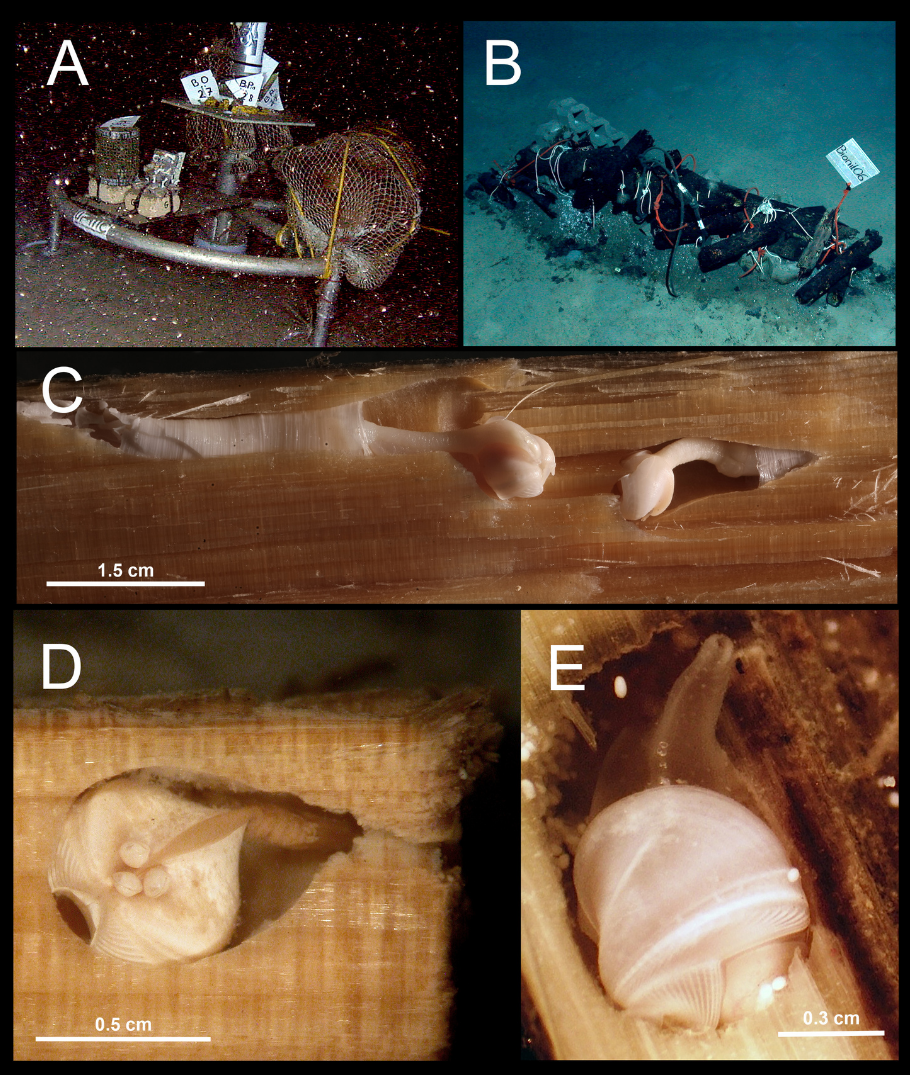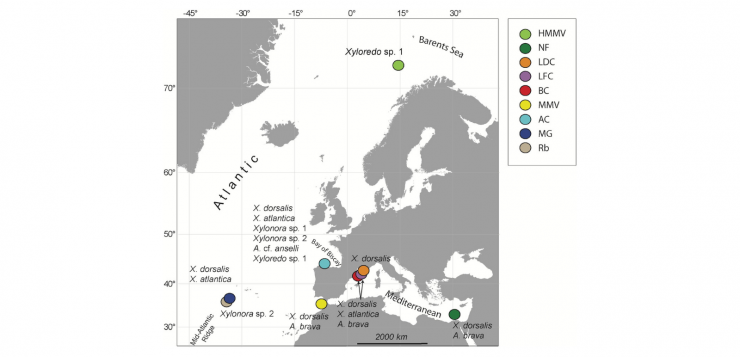Within the framework of the DeepFall Project (http://www.deepfall-project.eu), Chiara Romano and Daniel Martin, researchers of the Center for Advanced Studies of Blanes (CEAB-CSIC), have studied the diversity and biogeography of deep-sea wood-boring bivalve molluscs in the north-eastern Atlantic Ocean. In the study, carried out in collaboration with the Max Planck Institute of Marine Microbiology (Germany), the Banyuls Oceanographic Observatory (France), and the Scripps Institute of Oceanography of the University of California (USA), they have also described a new genus of the family Xylophagaidae that is able to take advantage of organic matter of terrestrial origin that arrives at the deep ocean.
Organic matter is never thrown away in the deep sea, not even wood!
Waste and debris, including pollutants and, of course, plastics, may eventually sink down to the deep oceans. Although the arrival of contaminants is negative for the marine ecosystem, the fall of organic matter of continental origin that reaches deep waters becomes a very important source of food supporting unique deep-sea life.
Wood creates small organic islands at the bottom of the sea and can host a very diverse fauna, including organisms specialized in degrading and digesting it thanks to their symbiotic cellulolytic microorganisms. The high oxygen consumption during this process transforms the environment into anoxic and sulfidic, thus promoting the development of chemosynthetic microbial communities and the presence of invertebrates associated with sulfide-oxidizing symbiotic microbes.
The wood-borer bivalves of the family Xylophagaidae are mainly responsible for the structural degradation of wood in the deep sea. They use wood as shelter and food source, as they have limited filter-feeding capacity (the usual mechanism by which many bivalves feed). These bivalves recycle wood and transform it into a form available to other organisms and are, therefore, key organisms for the communities that live in these ecosystems that are ephemeral and with a very patchy distribution. For these reasons their collection is rare and very little is known about their biology, diversity and geographic distribution.
Sunken wood experiments, morphological and molecular analyses
Using numerous experimental wood deployments, the diversity and biogeographic distribution of the Xylophagaidae have been studied in a broad range from boreal to temperate latitudes in North-East Atlantic and Mediterranean waters and from a depth range of 130 to 2.300 m.

The goals of the study were to (1) assess the diversity and phylogeny of Xylophagaidae, (2) provide their first barcode data, (3) reveal genetic connectivity patterns for populations of the most common species, and (4) draw up conclusions on ecological requirements of xylophagaid species.
Phylogenetic analyses, based on mitochondrial and nuclear genes (COI, 18S rRNA, 28S rRNA), showed that the genus Xylophaga was polyphyletic, which means it included organisms that derived from more than one single recent common ancestor. For this reason, the researchers reviewed their systematics and described a new genus that was named Xylonora.
By integrating morphology and genetics, the researchers demonstrated that the collected samples included seven different species, three of them undescribed and probably corresponding to new species. The remaining species presented contrasting characteristics. For instance, Xylophaga dorsalis and the member of the new genus Xylonora atlantica occurred frequently and showed wide Atlanto-Mediterranean distributions, broad bathymetric, thermal and salinity ranges, and a relatively high genetic connectivity. In contrast, Abditoconus brava was strictly a deep-sea species that occurred at both sides of the Mediterranean entrance but showed limited genetic connectivity.
By providing the first barcodes of the DNA of xylophagaid bivalves, the researchers hope to facilitate species discrimination and thus promote the acquisition of future taxonomic and ecological knowledge. The study proved also that experimentally deployed wood could be used as an efficient tool to collect this and other types of deep-sea organisms and improve our knowledge on their population dispersal abilities and connectivity. Undoubtedly, such research could provide crucial knowledge for planning strategies that facilitate the sustainable management of deep-sea species and ecosystems.
The article published in Frontiers Marine Science can be freely downloaded here.
DeepFall Project
The life of deep-sea organisms depends, in general, on the fall of particles and organic matter that comes from shallower waters. In the same way as those of natural origin, some materials of anthropogenic origin accumulate on the seabed. More specifically, the wood that reaches the sea and sinks to the deepest depths causes relevant changes in the ecosystem, among them the settlement of numerous deep-sea species stands out, from chemosynthetic bacteria to specialized invertebrates.
The DeepFall Project aims to contribute to the knowledge of deep-sea ecosystems and their biological phenomena, answering specific questions such as: what is the fate of land-based debris, especially wood, that accumulates on the ocean floor? What species can take advantage of sunken wood?
The project has received funding from the People Program (Marie Curie Actions) of the Seventh Framework Program of the European Union.


